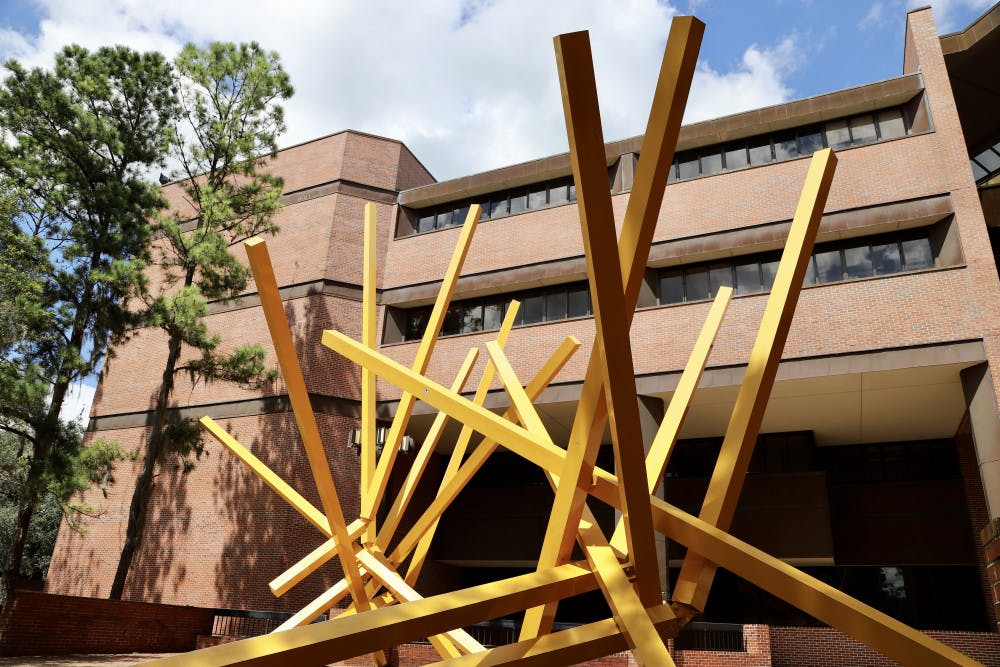UF President Kent Fuchs pledged to increase the amount of in-person courses offered in the Spring.
In a video posted to UF’s social media platforms Friday, Fuchs discussed the desire for more face-to-face classes, saying faculty and staff members already began the process this Fall.
“The next step we must take is to significantly increase the opportunity for students to experience in-person, face-to-face learning,” Fuchs said.
UF spokesperson Steve Orlando confirmed that commitment in an email Monday.
This Fall, 35% of courses at UF have been held in person or as hybrid and 35% are delivered in a synchronous format online, meaning the classes are held over the internet at a predetermined time.
“We have seen no disease transmission in classroom or lab settings during the Fall semester,” Orlando wrote, “and so we believe we can make the shift to more in-person classes while continuing to effectively protect the health and safety of our students, faculty and staff.”
That is despite a petition, one that amassed nearly 3,000 signatures as of Monday, proposed by United Faculty of Florida-UF, the faculty union, that urges UF to remain largely remote for the Spring.
The union was also strongly opposed to UF’s Fall reopening.
More than 3,100 UF students and faculty have tested positive for the virus since May, with testing numbers spiking in mid-September, according to UF’s testing dashboard.
UF’s quarantine procedures were also riddled with inconsistencies, leading to a response from administrators in The Alligator.
In-person graduation ceremonies for all 2020 UF graduates have been indefinitely canceled, with administrators citing the lack of a vaccine. The status of the Class of 2021’s commencement is still unknown.
“There is no justification to jeopardize the health and safety of faculty, staff and students by radically increasing [face-to-face] teaching in the Spring semester,” Paul Ortiz, the head of UFF-UF, wrote in a text message.
Spring registration for classes is set for Nov. 16. Classes begin Jan. 11, a week later than originally planned after Spring Break was canceled and Winter Break was extended during a September faculty senate meeting.
Fuchs attributed the push for more in-person courses to state funding, citing the need to maintain the current allocation from the State of Florida’s budget.
“Our best shared opportunity to retain full funding for our university, and thereby protect the jobs of our employees is to provide more of our students with the full educational opportunities they had before COVID,” Fuchs said.
But state appropriations do not appear tied to in-person classes. UF was allocated about $774 million by the state for the 2020-2021 year, an increase of more than $40 million from last year’s $733 million.
The General Revenue Fund, which manages the money used for college expenses — including classes — directed about $360 million to UF this year, an increase of more than $33 million from last year’s approximate $327 million, according to state documents.
When asked about the numbers, Orlando wrote that the appropriations do not reflect a 6% cut by the state, which was first referenced by Fuchs in his State of the University address in August and attributed to COVID-19. That cut would amount to about $32 million from the General Revenue Fund.
However, that would bring the fund down to $328 million — almost the same amount UF operated with last year.
Both the Board of Governors, which oversees the 12-member State University System, and the Governor’s Office did not respond in time for comment.
In the video, Fuchs said he understands the difficulty that switching to in-person classes will provide for faculty and staff, but believes the move is beneficial for students.
“We have learned over the past several months how to keep our faculty, staff and students as safe as possible with in-person teaching and learning,” Fuchs said.
UF unveiled its plans for face-to-face courses in a town hall with Provost Joseph Glover Tuesday.
For face-to-face classes, students and professors will have an 8-foot circle of space around them, allowing for social distancing throughout class, Glover said. An additional three feet will be in the front of the room between the professor and the front of the class.
Those will be taught through a “HyFlex” method, where professors can choose whether they want to deliver the course to both an online and in-person audience or tape them in-person and offer them for the online students to watch.
Glover also recommended that an online component should accompany those courses for students who don’t want to appear in person.
Instructors will be provided with an N95 mask and disinfecting wipes for their classroom, he said.
In his statement, Fuchs expressed his appreciation and views the move as one faculty will be able to accomplish over the next seven months.
“Many, many thanks,” he said.






